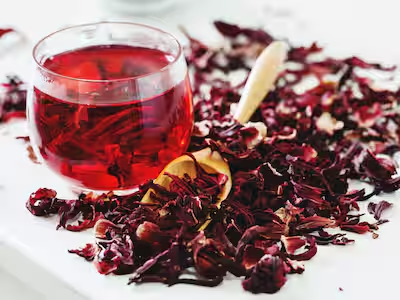Sheria
Also known as "Hibiscus tea," is a herbal tea made from the dried calyces of the hibiscus flower, scientifically known as Hibiscus sabdariffa. This vibrant, tart tea is enjoyed around the world both for its refreshing taste and numerous health benefits. Here’s a comprehensive look at hibiscus tea:
Ingredients and Preparation
Ingredients:
- Dried Hibiscus Flowers: The primary ingredient.
- Water: For brewing the tea.
- Sweeteners (optional): Sugar, honey, or agave syrup.
- Flavorings (optional): Ginger, cinnamon, or mint for added taste.
Preparation:
- Boiling: Bring water to a boil.
- Steeping: Add dried hibiscus flowers to the boiling water and let steep for 5-10 minutes, depending on the desired strength.
- Straining: Strain the liquid to remove the hibiscus flowers.
- Sweetening and Flavoring: Add sweeteners and any additional flavorings as desired.
- Serving: Serve hot or let it cool and serve over ice for a refreshing cold beverage.
Health Benefits
Hibiscus tea is not just a flavorful beverage but also offers several health benefits:
- Rich in Antioxidants: Helps fight free radicals in the body.
- Blood Pressure: Studies have shown that hibiscus tea can help lower blood pressure.
- Cholesterol: May help lower levels of LDL cholesterol.
- Liver Health: Promotes liver health by increasing detoxifying enzymes.
- Weight Management: May aid in weight loss by reducing the absorption of starch and glucose.
- Anti-inflammatory and Antibacterial Properties: Helps reduce inflammation and fight bacteria.
Cultural Significance and Global Variations
Hibiscus tea is known by different names and prepared in various ways around the world:
- Karkadeh: In Egypt and Sudan, it is known as karkadeh and is served both hot and cold.
- Agua de Jamaica: In Mexico and Central America, it is sweetened and served chilled as a popular refreshment.
- Bissap: In West Africa, particularly Senegal, it is known as bissap and is often flavored with mint or ginger.
- Roselle: In parts of Asia, hibiscus is referred to as roselle and is used in both tea and jams.
Nutritional Profile
Hibiscus tea is low in calories and caffeine-free, making it a healthy choice for many. It contains:
- Vitamin C: Boosts the immune system.
- Minerals: Such as calcium, iron, magnesium, and potassium.
- Anthocyanins: Compounds that give hibiscus its characteristic color and have various health benefits.
Potential Side Effects
While hibiscus tea is generally safe for most people, there are some considerations:
- Blood Pressure: Those with low blood pressure should consume it cautiously as it may lower blood pressure further.
- Pregnancy: Pregnant women are often advised to avoid hibiscus tea due to its potential to stimulate menstruation.
- Drug Interactions: It may interact with certain medications, particularly those for blood pressure and diabetes.
Culinary Uses
Beyond being a beverage, hibiscus is also used in various culinary applications:
- Jams and Jellies: Made from the hibiscus flowers.
- Salads: Fresh hibiscus flowers can be added to salads for color and flavor.
- Cocktails: Used as a base or flavoring in cocktails and mocktails.
Environmental and Economic Impact
Hibiscus cultivation is important in many regions for both local consumption and export. It is often grown in tropical and subtropical climates and provides economic benefits to farmers in these areas. Sustainable farming practices are crucial to ensure that hibiscus remains a viable crop without depleting local resources.
In summary, hibiscus tea is a globally enjoyed beverage known for its striking color, tart flavor, and numerous health benefits. Its cultural significance and versatility make it a beloved drink in many parts of the world.



